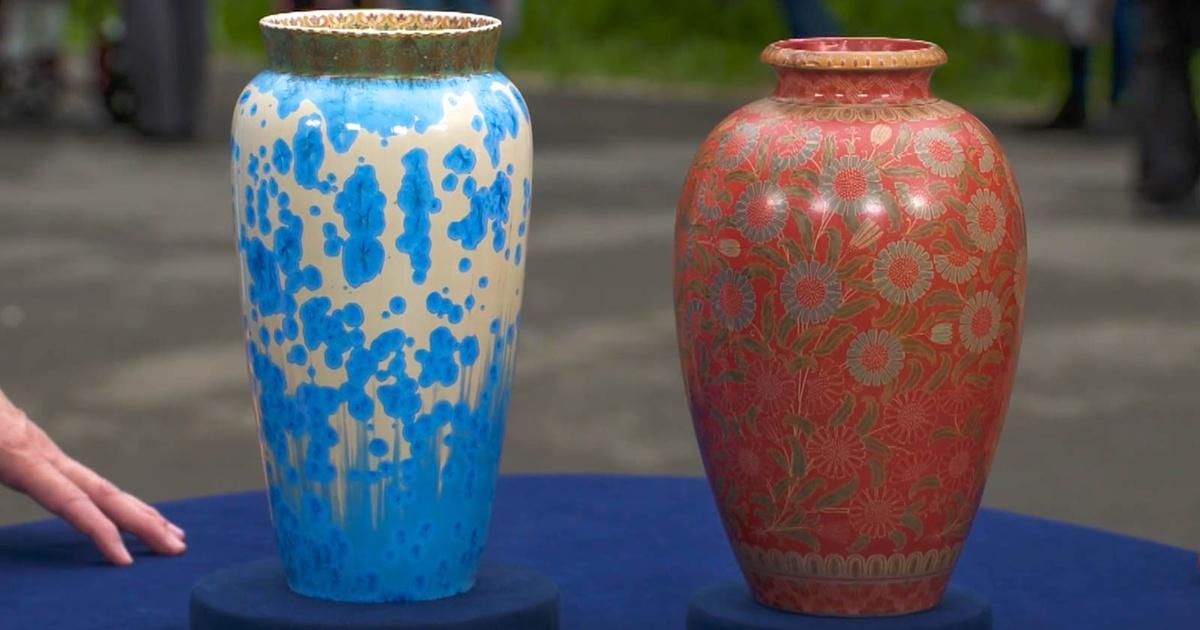
Antiques roadshow | appraisal: zsolnay vases, ca. 1895 | season 28 | episode 3
- Select a language for the TTS:
- UK English Female
- UK English Male
- US English Female
- US English Male
- Australian Female
- Australian Male
- Language selected: (auto detect) - EN
Play all audios:

GUEST: I inherited both vases from my parents. Um, my father was born in Hungary. He and his family were forced to leave because of the Nazis. They weren't practicing, but they were all
of, of Jewish descent. APPRAISER: What do you know about the vases here? GUEST: I know from the bottom that they're from "Soul-nay," I believe is how it's pronounced...
APPRAISER: Correct. GUEST: ...uh, in, in Hungary. I think that they belonged to my grandmother's sister. APPRAISER: Okay. GUEST: She was the youngest of the family. She was trained as a
concert violinist, and she ran off with a famous architect 25 or 30 years her senior. She ended up in Paris or near Paris during the war, got through that. Her husband died, and then she
came to this country, and eventually, um, my parents got them from her when she passed. I think they were from her husband. As an accomplished man of the world and an artist, probably
collected these. APPRAISER: Your great-aunt, did she leave Hungary after your grandparents to go to Paris? GUEST: I, I think probably before. APPRAISER: Okay, well, if, if she left before,
then it might make more sense that they had the ability to take possessions with them, because the later you waited, it was harder to bring things when you were fleeing the country. GUEST:
Right. APPRAISER: So you're right, they were made by a Hungarian company, Zsolnay, where they were located in Pécs. Now, the blue one has a raised mark. It has kind of a castle, and it
says "Zsolnay Pécs." And the raised mark, w, they quit using it in about 1920. And among collectors, it's a little bit more desirable. It has an impressed number, 5650, which
is a form number that was used between 1898 and 1900. The other vase has a mark, which, a similar mark, but it's flat. It has an impressed number, which seems to say 3939, which would
date it to between 1891 and 1895. The Zsolnay company started in about 1853, and the earlier products, from the 1850s, '60s, '70s, '80s, didn't look like, anything like
this. But by the 1890s, they'd been experimenting with all these wonderful new colors and glazes. And at that point, Hungary was kind of in the center of Europe, and so there was lots
of influence from all these other countries surrounding it, with interesting designs. GUEST: Hm. APPRAISER: This particular one here, if I just look at it, I'm, it's French. This
is absolutely French. I showed it to two other appraisers, and they were both, like, "I have never seen a piece of Zsolnay that looked like this." This decoration here is called a
crystalline glaze. This crystalline glaze was kind of a very French theme, and this type of glaze was a new innovation in terms of technology in pottery and porcelain. So it would have been
a very modern and exciting look. The top rim is raised gilding, and that's a very expensive technique. And actually, the top has a little bit of kind of an Egyptian design influence in
it. The other one has a completely different look. It's kind of a combination of kind of Islamic-inspired, but very English design. This vase, the blue one, even though it is so rare,
or we've never seen it before, it's not what Zsolnay collectors are looking for. GUEST: (chuckles) APPRAISER: A retail price on this one might be in the $2,000 to $3,000 range.
GUEST: Oh. APPRAISER: The red one, however, is almost classic Zsolnay design. It's really what collectors are looking for. That one would retail for somewhere between $3,000 and $5,000.
So together, we're looking at between $5,000 and $8,000. GUEST: Wow. (laughing): That exceeds my expectations greatly. It is a true connection to my Hungarian ancestors. It's a
life that's gone forever. (talking softly)
